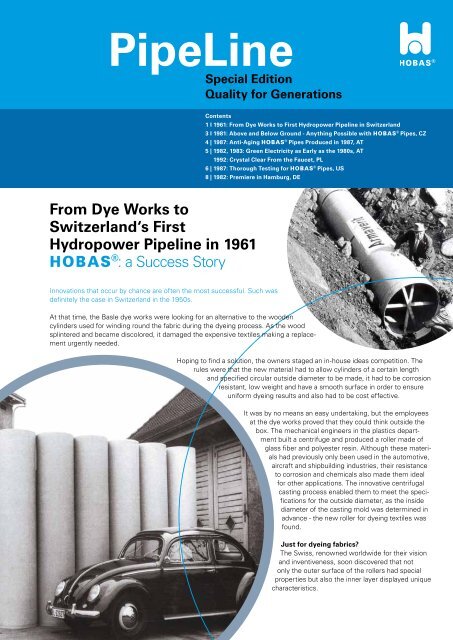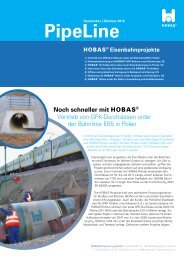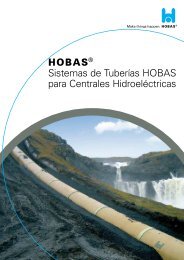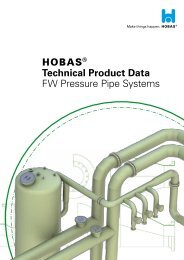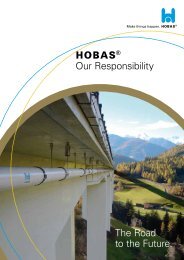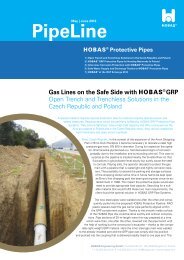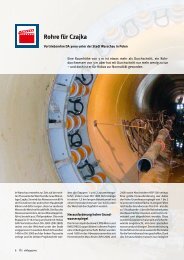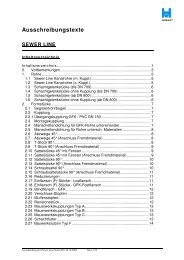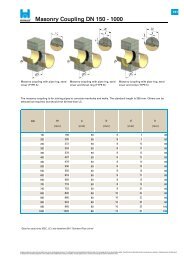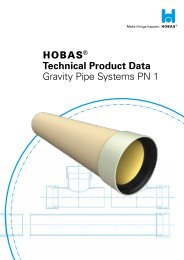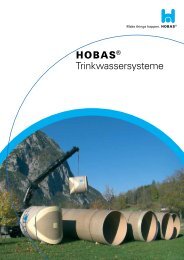PipeLine - Hobas
PipeLine - Hobas
PipeLine - Hobas
You also want an ePaper? Increase the reach of your titles
YUMPU automatically turns print PDFs into web optimized ePapers that Google loves.
<strong>PipeLine</strong><br />
From Dye Works to<br />
Switzerland‘s First<br />
Hydropower Pipeline in 1961<br />
h: a Success Story<br />
Special Edition<br />
Quality for Generations<br />
Innovations that occur by chance are often the most successful. Such was<br />
definitely the case in Switzerland in the 1950s.<br />
Contents<br />
1 I 1961: From Dye Works to First Hydropower Pipeline in Switzerland<br />
3 I 1981: Above and Below Ground - Anything Possible with h Pipes, CZ<br />
4 | 1987: Anti-Aging h Pipes Produced in 1987, AT<br />
5 | 1982, 1983: Green Electricity as Early as the 1980s, AT<br />
1992: Crystal Clear From the Faucet, PL<br />
6 | 1987: Thorough Testing for h Pipes, US<br />
8 | 1982: Premiere in Hamburg, DE<br />
At that time, the Basle dye works were looking for an alternative to the wooden<br />
cylinders used for winding round the fabric during the dyeing process. As the wood<br />
splintered and became discolored, it damaged the expensive textiles making a replacement<br />
urgently needed.<br />
Hoping to find a solution, the owners staged an in-house ideas competition. The<br />
rules were that the new material had to allow cylinders of a certain length<br />
and specified circular outside diameter to be made, it had to be corrosion<br />
resistant, low weight and have a smooth surface in order to ensure<br />
uniform dyeing results and also had to be cost effective.<br />
It was by no means an easy undertaking, but the employees<br />
at the dye works proved that they could think outside the<br />
box. The mechanical engineers in the plastics department<br />
built a centrifuge and produced a roller made of<br />
glass fiber and polyester resin. Although these materials<br />
had previously only been used in the automotive,<br />
aircraft and shipbuilding industries, their resistance<br />
to corrosion and chemicals also made them ideal<br />
for other applications. The innovative centrifugal<br />
casting process enabled them to meet the specifications<br />
for the outside diameter, as the inside<br />
diameter of the casting mold was determined in<br />
advance - the new roller for dyeing textiles was<br />
found.<br />
Just for dyeing fabrics?<br />
The Swiss, renowned worldwide for their vision<br />
and inventiveness, soon discovered that not<br />
only the outer surface of the rollers had special<br />
properties but also the inner layer displayed unique<br />
characteristics.
Year of Construction<br />
1961<br />
Total Length of Pipeline<br />
> 3 km<br />
Diameter<br />
DN 1000<br />
Pipe Specifics<br />
Pressure pipeline,<br />
wall thickness 7 mm<br />
Installation Method<br />
Open cut<br />
One thing led to another and<br />
the first centrifugally cast<br />
pipe made of glassfiberreinforced<br />
plastic (GRP) was<br />
produced in 1957. The Swiss<br />
initially manufactured rollers<br />
for their own use at the dye<br />
works and patented the production<br />
process shortly after.<br />
h <strong>PipeLine</strong> | Special Edition Quality for Generations | Page 02<br />
It was not long before the first<br />
external application in the form<br />
of pipes followed in 1961. In the<br />
Binn Valley in the Swiss canton<br />
of Valais, Gommerkraftwerke AG<br />
was seeking a suitable material for a<br />
pressure pipeline to their hydropower<br />
plant. When they heard about the excellent<br />
features and low weight of the centrifugally<br />
cast GRP pipes bearing the company<br />
name at that time, ARMAVERIT, it was soon clear<br />
what material they wanted for the three-kilometerlong,<br />
very steep sloping DN 1000 pipeline. The pipes were<br />
green inside and joined with bell sleeves.<br />
Today plant director Bernhard Truffer is still highly<br />
satisfied with the HOBAS Products, “especially when<br />
you take into consideration the very low wall thickness<br />
of 7 mm for a diameter of 1000 mm. What’s<br />
more, the pipes neither had ideal bedding nor were<br />
they installed or grounded properly”, adds Truffer<br />
extremely pleased with the experience that the<br />
company has had with the pipes over the past<br />
50 years. And HOBAS can justifiably be proud of<br />
producing quality for generations.<br />
HOBAS. Make things happen.<br />
Fmd: info@hobas.com<br />
Application<br />
HydropowerLine ®<br />
Client<br />
Gommerkraftwerke AG<br />
Advantages<br />
Low weight, easy<br />
installation, relatively<br />
thin wall, long service<br />
life, outstanding hydraulic<br />
properties
Above and Below Ground - Anything<br />
Possible with h Pipes Even in 1981<br />
In Use at a Paper Pulp Factory<br />
for Thirty Years, CZ<br />
At the beginning of the 1980s, HOBAS Pipes<br />
were installed in the Czech Republic for con-<br />
veying industrial wastewater and have enjoyed<br />
a great track record ever since.<br />
Biocel Paskov a.s., the paper pulp factory,<br />
is located in Paskov in the northeast of<br />
the Czech Republic and now belongs<br />
to the HEINZEL Group. Pulp has been<br />
produced in the small town for over a<br />
hundred years.<br />
From 1981 through 1984, pipes were<br />
installed in several stages for disposing<br />
of the effluent and conveying it to the<br />
wastewater treatment plant. A total of 14 km<br />
of HOBAS Pipes were used here and installed<br />
by open trench construction as well as<br />
above ground. Particularly interesting is<br />
the part of the line laid above ground.<br />
Its route includes a pipeline bridge<br />
over the River Ostravice and takes<br />
the industrial wastewater to the<br />
company’s treatment plant and a<br />
reservoir.<br />
Biocel Paskov’s operators are<br />
still delighted with the outstanding<br />
quality of the HOBAS<br />
Products and in a testimonial<br />
underscored the highly<br />
competent technical advice<br />
they received from the HOBAS<br />
Experts. The pipeline speaks for<br />
itself - it has now been in operation<br />
without any technical problems for<br />
three decades.<br />
Fmd: hobas.czech@hobas.com<br />
h <strong>PipeLine</strong> | Special Edition Quality for Generations | Page 03<br />
Left:<br />
HOBAS Pipes during<br />
installation at the beginning<br />
of the 1980s<br />
Below:<br />
Today, the 30-year-old<br />
pipeline still conveys<br />
the wastewater safely<br />
over the River<br />
Ostravice<br />
Year of Construction<br />
1981 - 1984<br />
Total Length of<br />
Pipeline<br />
14 km<br />
Installation Method<br />
Open cut,<br />
aboveground<br />
installation also on a<br />
pipeline bridge<br />
Application<br />
SewerLine ®<br />
(Industrial wastewater)<br />
Client<br />
Biocel Paskov a.s. (now<br />
part of the HEINZEL<br />
Group)<br />
Advantages<br />
Simple construction,<br />
long service life, installation<br />
possible above and<br />
below ground, excellent<br />
technical advice, outstanding<br />
quality
Year of Construction<br />
1987 - 1988<br />
Total Length of Pipeline<br />
1,143 m<br />
Diameter<br />
DN 1200 - DN 2200<br />
Pressure Class<br />
PN 1 - PN 8.5<br />
Stiffness Class<br />
SN 2500 - SN 10000<br />
Installation Method<br />
Open cut installation,<br />
encased in concrete in<br />
the dam and stream<br />
area, freely installed in<br />
the tunnel<br />
h <strong>PipeLine</strong> | Special Edition Quality for Generations | Page 04<br />
Application<br />
HydropowerLiner<br />
Client<br />
Salzburg AG<br />
Contractor<br />
ARGE Polensky & Zöller<br />
Advantages<br />
Abrasion and corrosion<br />
resistance, long service<br />
life, quick and easy<br />
installation, low weight,<br />
excellent hydraulic<br />
properties<br />
Anti-Aging h<br />
Pipes Produced in 1987<br />
Pipeline Withstands Highly<br />
Abrasive Glacial Sediment, AT<br />
The Wald hydropower plant enjoys a picturesque setting at the<br />
edge of the Hohe Tauern National Park and takes advantage of<br />
the considerable difference in elevation between the villages of<br />
Krimml and Wald. Built by Salzburg AG in the 1980s, it has been in<br />
operation since fall 1988 to meet the rising energy demand in the surrounding<br />
area.<br />
Top priority when planning this project were environmental protection<br />
and nature conservation. As the national park is such a sensitive area,<br />
extreme care was also taken both during construction of the power station<br />
and installation of the pipeline to comply with the stringent legislation.<br />
The powerhouse is situated in Wald, while the water intake was<br />
built around 200 meters higher up in the village of Krimml not far from<br />
the famous waterfalls. A daily storage reservoir with a capacity of 65,000<br />
cubic meters and a dam body were integrated in the existing terrain,<br />
landscaped and planted. The water intake is an inconspicuous structure<br />
and has a very well designed fish ladder that looks virtually like a natural<br />
creek. Strict regulations were observed during installation of the HOBAS<br />
Pipeline to prevent flora and fauna from being disturbed.<br />
Like most parts of the hydropower pipeline, the penstock between the<br />
daily storage reservoir and headrace tunnel was buried. A DN 2200,<br />
PN 4-6 pressure pipeline measuring 840 meters in length constituted<br />
the first part of the penstock. It is encased in concrete in the area of the<br />
storage dam and the Krimmler Ache river crossing.<br />
After 18 years in operation, the sand flushing pipeline in the hydropower<br />
plant consisting of DN 2200, PN 1 HOBAS Pipes underwent inspection<br />
by the owner and HOBAS Experts in March 2006. The engineers were<br />
delighted to find that even after having been in service for nearly two decades,<br />
the pipeline showed hardly any signs of wear. Despite the highly<br />
abrasive medium – water with sand and glacial sediment – the inner pure<br />
resin layer that is also responsible for the unique hydraulic properties of<br />
HOBAS Pipes was neither pitted nor worn away and also in the invert<br />
area of the pipes the liner was completely intact.<br />
Just how aggressive glacial sediment is on most materials can be seen<br />
from the fact that the power plant’s turbine had to be replaced several<br />
times over the same period – the HOBAS Pipeline however shone like<br />
new against the light. Even the original installation numbering on the<br />
pipes was largely still visible and only slight signs of mechanical<br />
abrasion could be detected on the markings.<br />
The management at Salzburg AG has every reason to be more<br />
than happy with this project and many following generations can<br />
rely on the quality of HOBAS Pipes.<br />
Fmd: hobas-rohre.austria@hobas.com
h <strong>PipeLine</strong> | Special Edition Quality for Generations | Page 05<br />
Green Electricity as Early as the 1980s<br />
Clean Power with h Pipes, AT<br />
The hydropower plant pipelines in Rauris and Mariensee in Austria have also earned top<br />
marks. Following several decades in operation, their test results are even better than<br />
predicted, making Mother Nature happy to embrace HOBAS Pipes.<br />
No less than 175,200 hours or 7,300 days or 20 years: that is how long a DN 500,<br />
PN 36, SN 10000 HOBAS Pressure Pipeline produced in Austria in 1983 was in use<br />
at a hydropower plant in Rauris, Austria, before HOBAS Experts subjected a pipe<br />
sample to tests at the laboratory. They then compared the actual results with the<br />
assumed long-term regression curve: both stiffness and failure pressure were<br />
substantially higher than that required by the standard, testifying<br />
to the excellent properties of HOBAS Pipes.<br />
“I would use HOBAS Pipes again,” says hydropower<br />
plant operator Stefan Schenker reassuringly and<br />
totally satisfied with the DN 800, PN 1, SN 5000<br />
HOBAS HydropowerLine ® Pipes that were laid<br />
in Mariensee in Lower Austria in 1982. In<br />
particular the products‘ low weight was a great<br />
advantage during aboveground installation in the<br />
steep, very rough terrain. After six weeks, the<br />
570 meter section was completed. Some<br />
30 years later, the moss-covered pipes have<br />
become a harmonious part of the landscape –<br />
Mother Nature loves HOBAS too...<br />
Fmd: hobas-rohre.austria@hobas.com<br />
Crystal Clear From the Faucet Since 1992<br />
h Ensures Reliable Potable Water Supply, PL<br />
In Poland, a pipeline has been supplying potable water<br />
safely and reliably to people in Wrocław for around<br />
20 years.<br />
A new potable water line consisting of DN 300 HOBAS<br />
WaterLine ® Pipes was laid in Wrocław in Poland in 1992.<br />
The PN 16 class pressure pipes have a stiffness of<br />
SN 10000 and have been conveying potable water safely<br />
and reliably to the population since then. After about<br />
twenty years, the original pipeline was altered and<br />
HOBAS received pipe segments for long-term testing.<br />
Even the HOBAS Experts were impressed to find that the<br />
potable water pipes did much better than expected in all<br />
the tests. The mechanical properties in particular by far<br />
exceeded the levels required by the standard, as you can<br />
see from the graph on the right.<br />
Fmd: hobas.poland@hobas.com<br />
Top:<br />
HOBAS Austria<br />
over three<br />
decades ago<br />
Left:<br />
Moss-covered<br />
pipes – nature<br />
embraces HOBAS
h <strong>PipeLine</strong> | Special Edition Quality for Generations | Page 06<br />
Thorough Testing Since 1987<br />
Texas Has Been Able to Rely on<br />
h Pipes for over 20 Years, US<br />
When our quality management teams get to test pipes that have been in service for several<br />
decades, their eyes light up. And they have every right to be proud that the test results are always<br />
much better than predicted or required by the applicable standards.<br />
HOBAS has had a plant in the United States since 1987. One of the first projects was a pipeline near<br />
Odessa in western Texas. It required DN 450, PN 10, SN 5000 HOBAS GRP Pipes to take brackish<br />
water to the nearby oil fields for use in processing. The six-meter-long pipes totaled 44 km in length<br />
and were joined with HOBAS FWC Couplings. After installation, the pipeline was successfully<br />
tested at 12 bar and went into operation in 1987. It then remained in place with the pressure<br />
maintained at 5 to 7 bar.<br />
Years and years went by uneventfully until the pipeline owner contacted the HOBAS Experts in June<br />
2009. The group operating Centurion Pipeline L.P., a subsidiary of Occidental Petroleum Corporation,<br />
approached HOBAS, as an adjacent third-party pipeline had burst, damaging parts of the HOBAS<br />
Pipeline and they urgently needed replacement pipes. Responding quickly, the HOBAS Plant manufactured<br />
and supplied 24 meters of DN 450 HOBAS Pipes within a short space of time.<br />
The pipes damaged by the burst adjacent pipeline were taken to the HOBAS Laboratory where they<br />
underwent close scrutiny. „We took a look at the records we keep for all products we make<br />
and found that the pipes used were among the first to be centrifugally cast in the<br />
United States in November 1987“, explains Pepe Rodriguez, quality control<br />
supervisor at HOBAS Pipe USA. Being able to test pipe<br />
segments after use is a very rare occurrence<br />
because they usually remain in service<br />
over their entire useful lives.<br />
Year of Construction<br />
1987<br />
Total Length of Pipeline<br />
44 km<br />
Diameter<br />
DN 450<br />
Pressure Class<br />
PN 10 - 12<br />
Stiffness Class<br />
SN 5000<br />
Installation Method<br />
Open cut<br />
Application<br />
Brackish water supply<br />
Client<br />
West Texas Water<br />
Supply System<br />
Contractor<br />
Key Enterprises<br />
Advantages<br />
Quick installation, long<br />
service life, corrosion<br />
resistance
After 21-and-a-half years,<br />
the pipes used for the brine<br />
pipeline were tested to check<br />
their mechanical properties. A<br />
range of procedures to ASTM<br />
standards revealed that the products<br />
performed better in all tests<br />
than the original project specifications<br />
had required.<br />
„When they were planning the pipeline, they<br />
selected HOBAS Products made of glassfiberreinforced<br />
plastic because they are extremely<br />
corrosion resistant,“ says Rick Turkopp of<br />
HOBAS Pipe USA looking back. „The brackish<br />
water is normally at a temperature of 32 to 35<br />
degrees Celsius and contains hydrogen sulfide.<br />
This corrosive mixture limits the service life of<br />
other materials to a maximum of 15 years.“ The<br />
tests on the HOBAS Pipeline however confirmed<br />
that the products designed for 50 years and<br />
more actually last that long.<br />
It therefore comes as no surprise that the pipeline<br />
operators are exceedingly pleased with the<br />
HOBAS Products. In use since installation, there<br />
have never been any problems. Since 1987,<br />
HOBAS Pipes have been ensuring that the<br />
brackish water is reliably conveyed and will<br />
continue to do so for many years to come.<br />
Fmd: hobas.usa@hobas.com<br />
h <strong>PipeLine</strong> | Special Edition Quality for Generations | Page 07<br />
Top:<br />
Pepe Rodriguez<br />
with the old and new HOBAS Pipes<br />
Below:<br />
The old pipes undergo<br />
strict testing and<br />
deliver impressive<br />
results
Premiere in Hamburg<br />
in 1982<br />
The First Large-Scale and Technically<br />
Demanding GRP Jacking<br />
Project in the World, DE<br />
HOBAS made its debut with Centrifugally Cast GRP Jacking Pipes in<br />
1982. Before then, the pipes had only been used on some test con-<br />
struction sites in northern Germany for pushes of up to 50 meters.<br />
The world‘s first large and technically highly demanding jacking project<br />
with GRP products was undertaken at Hamburg‘s customs port.<br />
A sewer was to be installed under a very busy part of the port in the<br />
north of Germany. The specifications were challenging: a fire service<br />
exit, port railway and federal railway lines were not to be disrupted<br />
under any circumstances and settling had to be prevented over the<br />
entire length of the pipeline. Given the fact that trenchless construction<br />
saves space and is highly accurate, jacking was truly predestined for this<br />
application. The HOBAS Products‘ corrosion resistance also to aggressive<br />
wastewater, their smooth outer surface and easy handling persuaded the<br />
clients and they ordered jacking pipes with an outside diameter of<br />
752 mm and wall thickness of 50 mm. The pipes were installed six meters<br />
under the groundwater table in two drives over a length of 165 meters<br />
without any intermediate jacking stations.<br />
Although their outer surface is very smooth, the HOBAS Pipes were<br />
lubricated with bentonite every 30 meters to reduce friction and<br />
speed up the jacking work. It is hardly surprising therefore that<br />
the greatest jacking force used was only 1700 kN, which is far<br />
less than the limit for the pipes. What is also remarkable is<br />
the great precision with which the HOBAS Pipes were jacked<br />
through the silt and clay soil under the groundwater table at<br />
that time: the pipeline only deviated 15 mm from the planned<br />
route over a length of more than 100 meters, thus remaining<br />
well below the specified tolerance.<br />
The facts sounded spectacular then but are now exceeded many<br />
times over. In 2009, HOBAS supplied De 3000 jacking pipes that<br />
were installed without using the intermediate jacking stations in<br />
sections of almost a kilometer...<br />
Fmd: hobas-rohre.germany@hobas.com<br />
© E Engineering GmbH, 04/2010<br />
Pischeldorfer Str. 128 | 9020 Klagenfurt | Austria<br />
T +43.463.48 24 24 | F +43.463.48 21 21<br />
info@hobas.com | www.hobas.com<br />
h <strong>PipeLine</strong> | Special Edition Quality for Generations | Page 08<br />
Responsible for texts, layout & graphics: Sabine Friesser | Print: Ernst Ploetz, Druck- und Verlagshaus GmbH<br />
Year of Construction<br />
1982<br />
Total Length of Pipeline<br />
165 m<br />
Diameter<br />
De 752<br />
Wall Thickness<br />
50 mm<br />
Installation Method<br />
Jacking<br />
Application<br />
SewerLine ®<br />
Advantages<br />
Corrosion resistance,<br />
smooth outer surface,<br />
easy handling<br />
E Group Worldwide<br />
HOBAS manufactures and markets HOBAS CC-GRP Pipe Systems. The HOBAS Network includes<br />
HOBAS Production Facilities and Sales Organizations in Europe and throughout the world.<br />
All rights reserved. No part of this document may be reproduced or utilized in any form or by any means without our prior written permission. All informa-<br />
tion in the document is correct at the time of going to press. However, we reserve the right to make changes without notice, in particular to technical data.<br />
The data given is not binding and must therefore be checked in each individual case and revised as appropriate.


